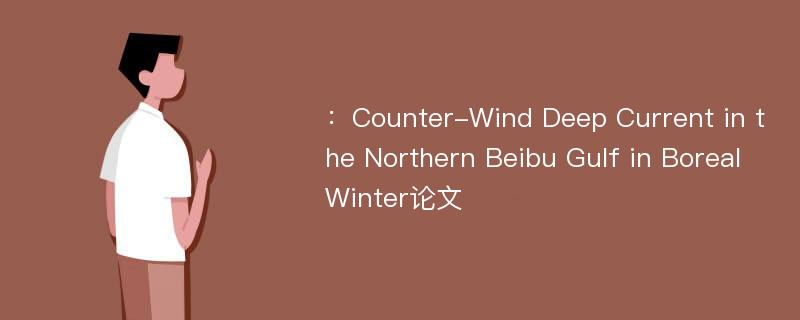
本文主要研究内容
作者(2019)在《Counter-Wind Deep Current in the Northern Beibu Gulf in Boreal Winter》一文中研究指出:The Beibu Gulf is at an important geographical location and rich in gas, oil and biological resources. The observed currents showed that the current in the upper layer was opposite to that in the lower layer in boreal winter in the northern Beibu Gulf and it was northeastward in the lower layer. This northeastward current was reproduced by a 3 D baroclinic model in this study. It’s found that the counter-wind deep current(referred to as ‘CWDC’ hereinafter) strengthened from September to November but weakened from December to the following February. A closed meridional circulation in vertical direction was found in the northern Beibu Gulf, including CWDC, surface southwestward current, an upwelling, and a downwelling. The temporal variation process of the meridional circulation was similar to that of CWDC, with strength and range stronger in November and December than in other four months. Similar to the variation process of CWDC, the monsoon wind changed from weak easterly wind in September to strong northeasterly wind in November and December, and it was transformed into weak southeasterly wind in February again. The sensitive experiments showed that CWDC and the meridional circulation were controlled by the monsoon wind and were adjusted by heat flux-and tide-induced mixing, respectively. According to the momentum balance equation, it can be revealed the counter-wind deep current is a compensation current which is induced by the surface elevation gradient balanced by the Coriolis force, vertical diffusion and baroclinic pressure gradient.
Abstract
The Beibu Gulf is at an important geographical location and rich in gas, oil and biological resources. The observed currents showed that the current in the upper layer was opposite to that in the lower layer in boreal winter in the northern Beibu Gulf and it was northeastward in the lower layer. This northeastward current was reproduced by a 3 D baroclinic model in this study. It’s found that the counter-wind deep current(referred to as ‘CWDC’ hereinafter) strengthened from September to November but weakened from December to the following February. A closed meridional circulation in vertical direction was found in the northern Beibu Gulf, including CWDC, surface southwestward current, an upwelling, and a downwelling. The temporal variation process of the meridional circulation was similar to that of CWDC, with strength and range stronger in November and December than in other four months. Similar to the variation process of CWDC, the monsoon wind changed from weak easterly wind in September to strong northeasterly wind in November and December, and it was transformed into weak southeasterly wind in February again. The sensitive experiments showed that CWDC and the meridional circulation were controlled by the monsoon wind and were adjusted by heat flux-and tide-induced mixing, respectively. According to the momentum balance equation, it can be revealed the counter-wind deep current is a compensation current which is induced by the surface elevation gradient balanced by the Coriolis force, vertical diffusion and baroclinic pressure gradient.
论文参考文献
论文详细介绍
论文作者分别是来自Journal of Ocean University of China的,发表于刊物Journal of Ocean University of China2019年01期论文,是一篇关于,Journal of Ocean University of China2019年01期论文的文章。本文可供学术参考使用,各位学者可以免费参考阅读下载,文章观点不代表本站观点,资料来自Journal of Ocean University of China2019年01期论文网站,若本站收录的文献无意侵犯了您的著作版权,请联系我们删除。
